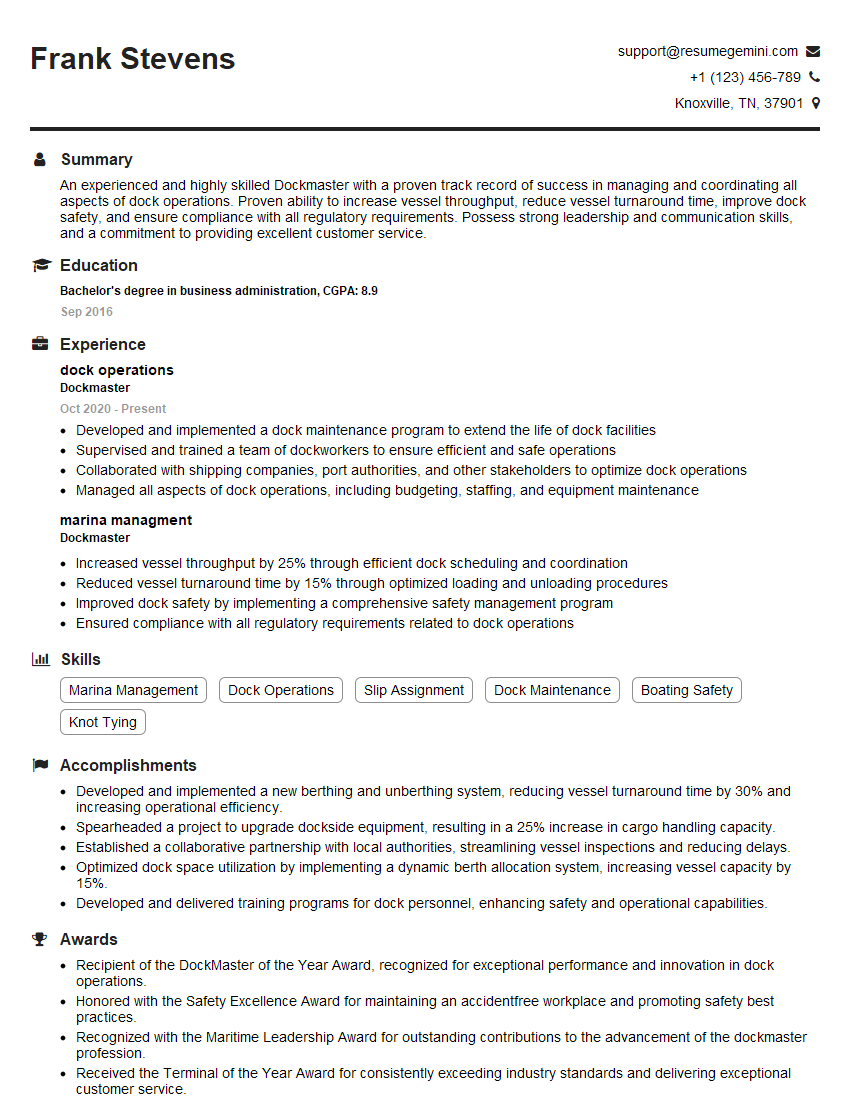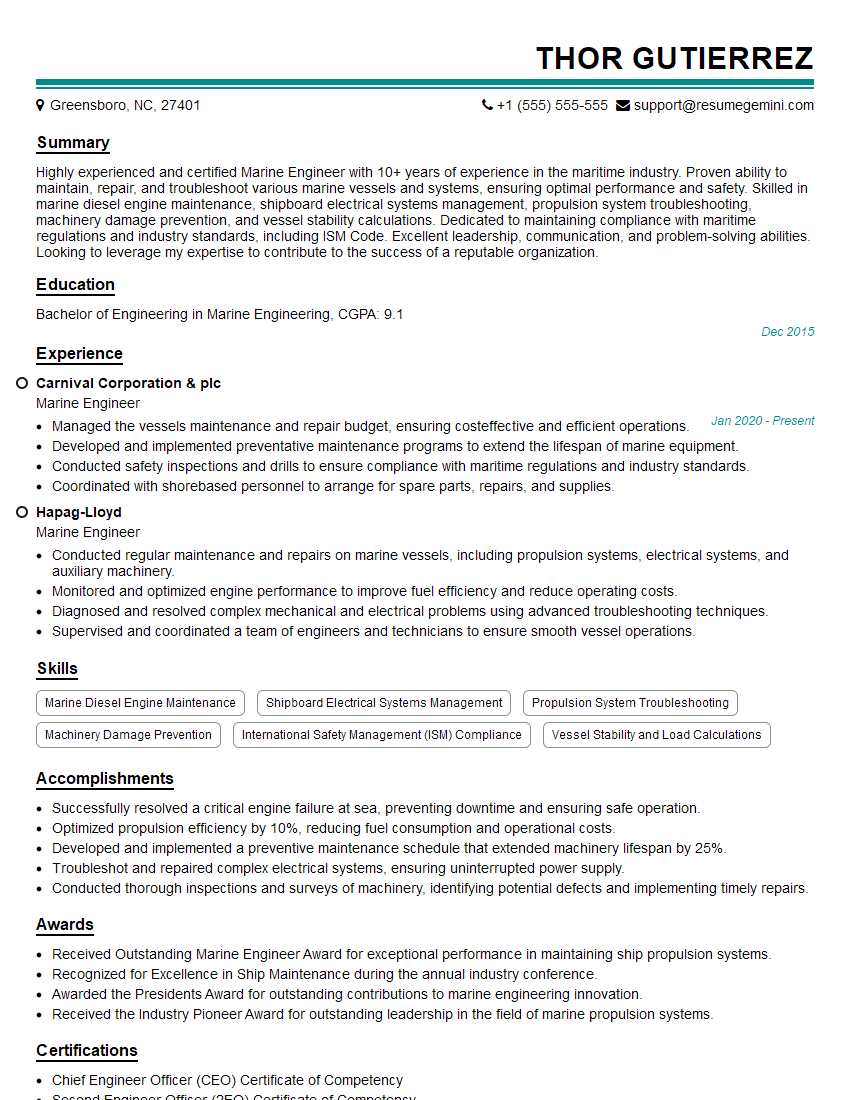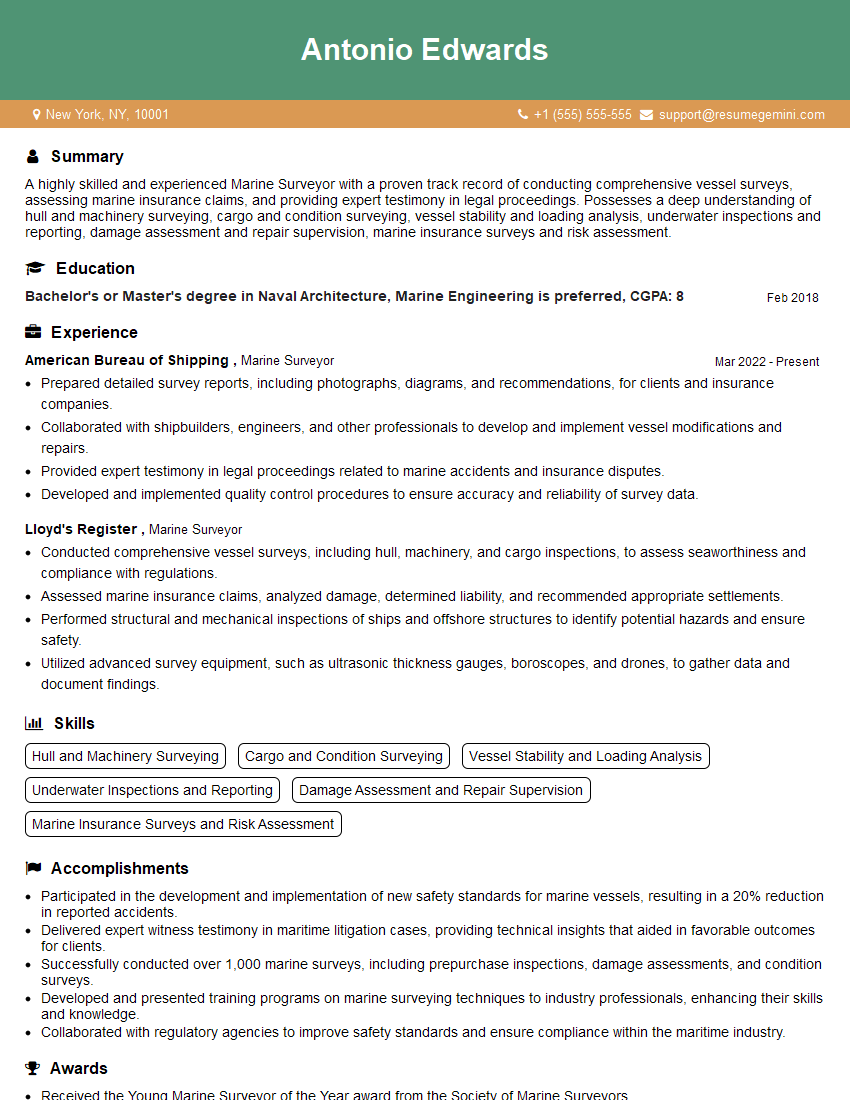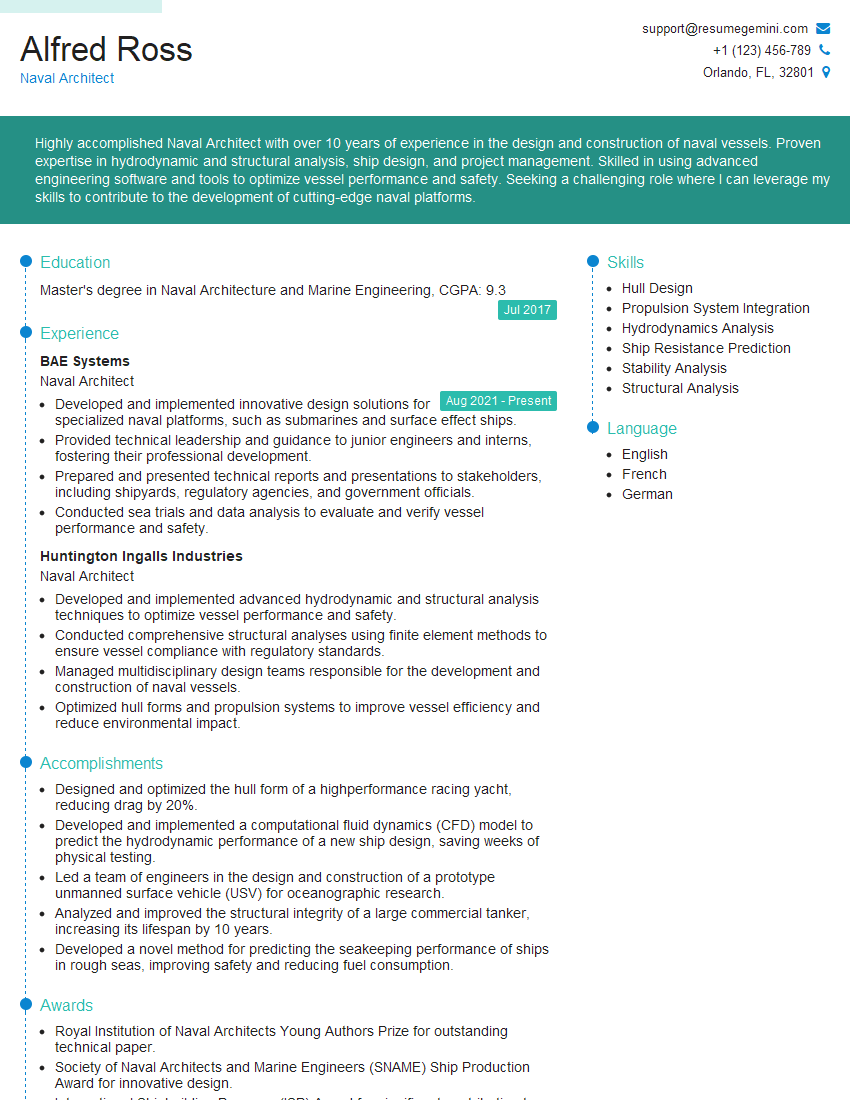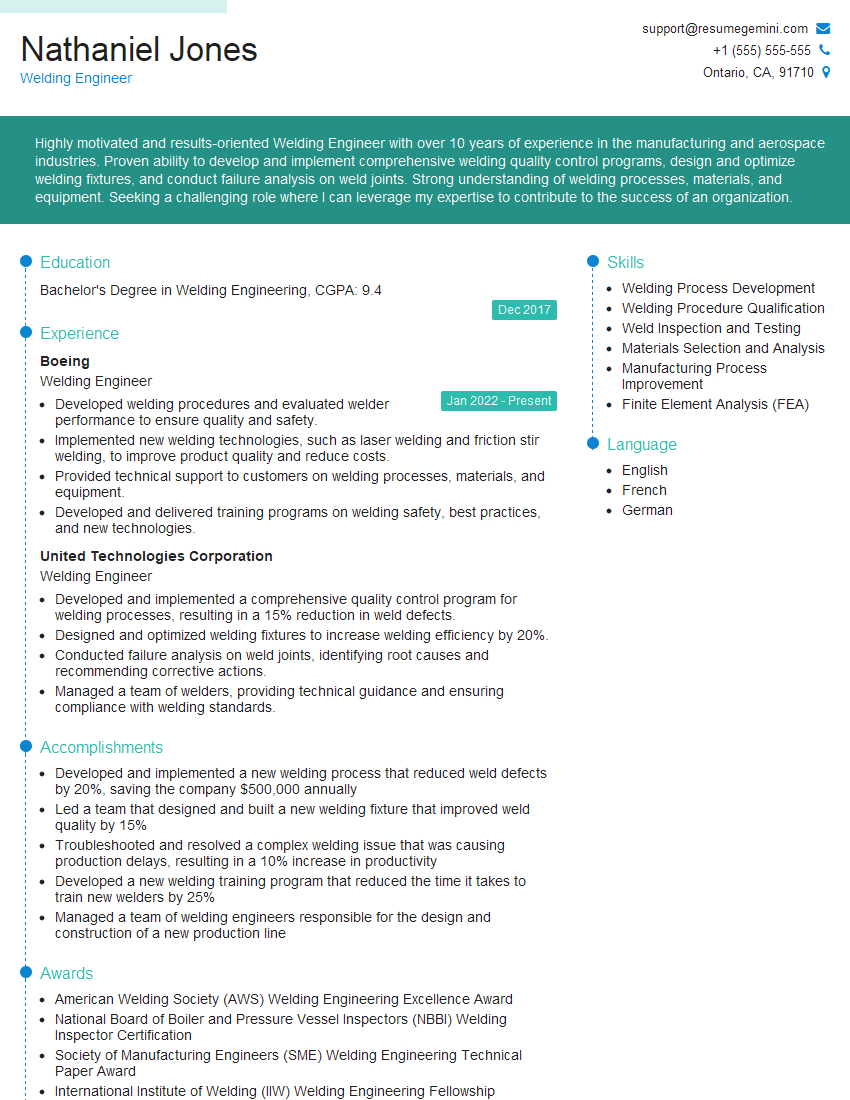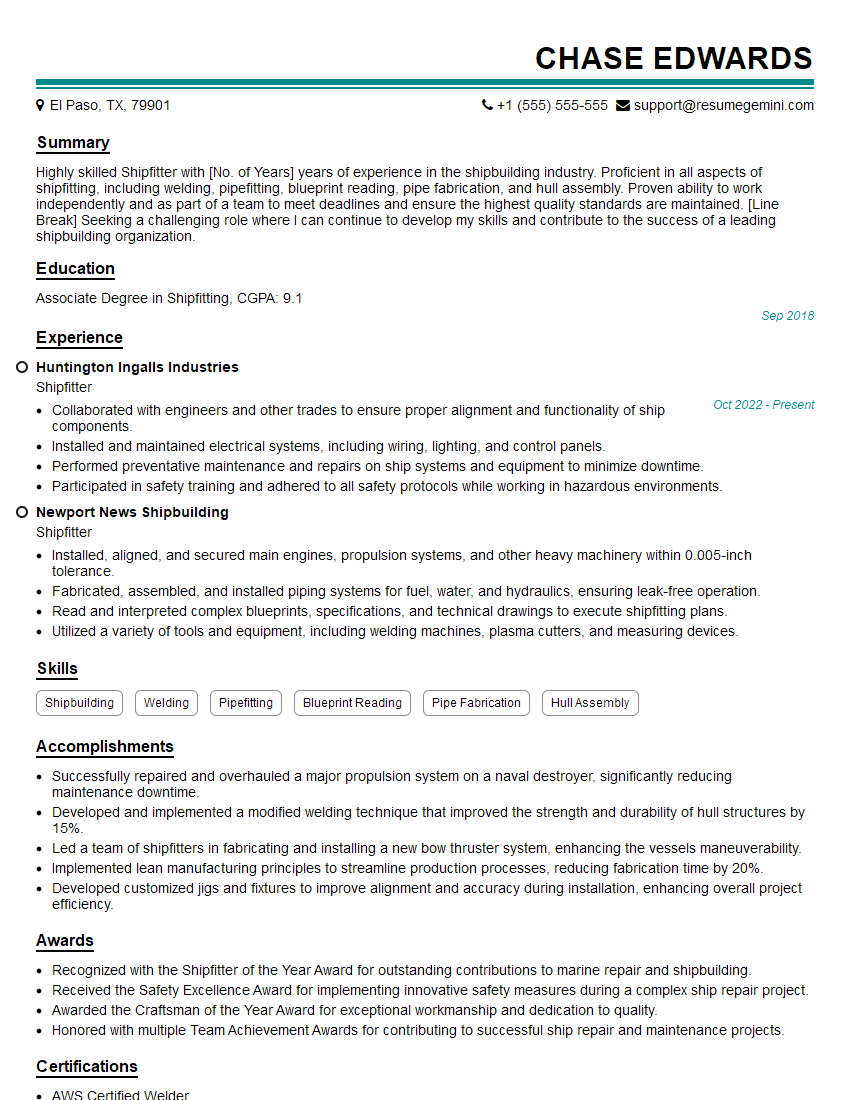Are you ready to stand out in your next interview? Understanding and preparing for Shipbuilding Techniques interview questions is a game-changer. In this blog, we’ve compiled key questions and expert advice to help you showcase your skills with confidence and precision. Let’s get started on your journey to acing the interview.
Questions Asked in Shipbuilding Techniques Interview
Q 1. Explain the different types of ship construction methods.
Ship construction methods broadly fall into two categories: traditional and modern. Traditional methods, still used for smaller vessels and specialized repairs, often involve manual shaping and assembly of components. Modern methods leverage advanced technologies for increased efficiency and precision.
- Traditional Methods: These include techniques like riveting (though largely phased out for larger vessels due to welding’s superiority), where metal plates are joined using rivets, and timber framing for wooden hulls. Think of classic sailing ships; their construction heavily relied on these techniques.
- Modern Methods: These incorporate modular construction (building sections separately and assembling them), block construction (assembling large prefabricated sections), and the extensive use of welding, creating stronger and more streamlined vessels. Many modern cruise ships or container vessels use these modern methods, allowing for quicker construction and better quality control.
The choice between methods depends on factors such as vessel size, complexity, cost, and available technology. A small fishing boat might still be constructed using a more traditional method, whereas a large oil tanker would require the highly efficient modular or block construction techniques.
Q 2. Describe the process of hull fabrication.
Hull fabrication is a complex process involving several stages. It starts with design and planning, moving through material preparation, cutting, forming, and joining components, and concluding with surface treatment and quality checks.
- Design and Planning: This stage involves detailed engineering drawings created using CAD software, defining every plate, beam, and structural component. Think of it as the blueprint for the ship’s skeleton.
- Material Preparation: Steel plates, the most common material, are cut to precise dimensions using plasma cutting or laser cutting machines. Other materials might include aluminum or fiberglass, depending on the vessel’s type and intended use.
- Plate Forming and Shaping: Plates are often shaped into curves using specialized machines like roll benders and press brakes to conform to the hull’s designed contours. This is crucial for creating the vessel’s hydrodynamic shape.
- Component Assembly and Welding: Individual plates and structural elements are joined using various welding techniques, such as submerged arc welding (SAW) for larger sections and gas metal arc welding (GMAW) for smaller or more complex joints. This stage requires highly skilled welders who must adhere to rigorous quality standards.
- Surface Treatment and Finishing: After welding, the hull undergoes surface treatment, including cleaning, priming, and painting to prevent corrosion and protect the steel. This is crucial for the longevity of the vessel.
Imagine building a giant jigsaw puzzle where each piece is precisely cut and welded together. The precision and skill at each stage are vital for the structural integrity and performance of the finished hull.
Q 3. What are the key considerations in selecting materials for shipbuilding?
Material selection is paramount in shipbuilding, balancing factors like strength, weight, cost, corrosion resistance, and weldability. The choice depends heavily on the vessel’s intended use and environmental conditions.
- Steel: The most common material due to its high strength-to-weight ratio, weldability, and relatively low cost. Different grades of steel are used depending on the strength requirements. For example, high-strength steel might be used in areas subjected to high stress, while milder steel might be suitable for less critical areas.
- Aluminum: Used in high-speed vessels (e.g., ferries) due to its lighter weight, though it is more expensive and has limitations in weldability compared to steel.
- Fiberglass-Reinforced Polymer (FRP): Suitable for smaller vessels and specialized applications, offering corrosion resistance and ease of molding, but lower strength compared to steel or aluminum. Think of smaller pleasure crafts or specialized research vessels.
- Other Materials: Other materials, such as wood (for smaller traditional boats), composite materials, and titanium (for very specialized applications), might be used based on specific needs.
The selection process usually involves detailed material property analysis and consideration of the operational environment – a vessel operating in Arctic conditions will require different material specifications than one in tropical waters.
Q 4. Explain the importance of structural integrity in shipbuilding.
Structural integrity is non-negotiable in shipbuilding. A ship’s hull must withstand immense forces from waves, wind, and cargo weight. Compromised integrity can lead to catastrophic failures, resulting in loss of life and significant financial losses.
Several factors contribute to structural integrity:
- Proper Design: Advanced computational fluid dynamics (CFD) and finite element analysis (FEA) are used to simulate stresses and strains on the hull, ensuring it can withstand anticipated loads. This is vital for ensuring the ship can sail safely in stormy seas.
- Quality Materials: Selecting appropriate materials that meet specified strength and corrosion resistance requirements is crucial. Using substandard materials would be a grave mistake.
- Skilled Fabrication: Precise cutting, forming, and welding are essential to ensure structural soundness. Poor welding, for example, can create weak points that compromise the overall structure.
- Regular Inspections and Maintenance: Regular inspections and maintenance help detect and address potential problems before they escalate into serious issues. This proactive approach is key to longevity and safety.
Imagine a building – you wouldn’t want to compromise its structural integrity. Similarly, a ship’s structural integrity is paramount to its safe and reliable operation.
Q 5. How do you ensure quality control during shipbuilding?
Quality control (QC) in shipbuilding is a rigorous process implemented at every stage, from design to delivery. It ensures the vessel meets specified standards, regulations, and client requirements.
- Material Testing: Materials are inspected for defects and tested to ensure they meet specified strength, toughness, and chemical composition requirements.
- Welding Inspection: Welders are certified, and their work is inspected using non-destructive testing (NDT) methods like radiography (X-ray), ultrasonic testing, and visual inspection to identify any flaws or defects.
- Dimensional Control: Regular measurements are taken throughout the construction process to ensure components are built to the correct dimensions and tolerances. Deviation from the plans could compromise the integrity of the structure.
- Third-Party Audits: Independent classification societies, such as DNV GL or ABS, conduct audits and inspections to verify that the construction process adheres to international standards and regulations.
- Documentation and Traceability: Detailed records are kept throughout the construction process to track materials, welding procedures, inspections, and any remedial actions taken. This traceability is vital for accountability and problem-solving.
Imagine a doctor performing surgery; every step is precise and documented. Similarly, quality control in shipbuilding needs to be thorough and meticulous to guarantee safety and reliability.
Q 6. Describe your experience with different welding techniques in shipbuilding.
My experience encompasses a wide range of welding techniques commonly employed in shipbuilding, including:
- Shielded Metal Arc Welding (SMAW): A versatile technique suitable for various joint types and materials, commonly used for smaller sections and repairs. It’s relatively portable and can be used in various locations.
- Gas Metal Arc Welding (GMAW): Widely used for its high deposition rate and good quality, often employed in automated systems for large-scale fabrication. It’s very efficient and ideal for repetitive welds.
- Submerged Arc Welding (SAW): Primarily used for joining thick plates and producing high-quality welds with deep penetration. It’s an extremely productive method for large sections of the hull.
- Gas Tungsten Arc Welding (GTAW): This technique excels in producing high-quality welds on thinner materials, often used in critical areas requiring precise control. It’s suitable for applications requiring superior cosmetic appearance.
The selection of the appropriate welding technique depends on factors such as plate thickness, material type, joint design, accessibility, and required weld quality. For instance, SAW is preferred for joining thick steel plates in the hull’s main structural members, while GMAW might be used for smaller components or deck structures. My expertise allows me to select and supervise the execution of the most appropriate technique for the task at hand ensuring adherence to strict quality control standards.
Q 7. Explain the role of CAD/CAM software in shipbuilding.
CAD/CAM software plays a crucial role in modern shipbuilding, revolutionizing design, fabrication, and production processes. It improves efficiency, accuracy, and collaboration.
- 3D Modeling and Design: CAD software allows engineers to create detailed 3D models of the entire vessel, including the hull, superstructure, and internal systems. This allows for visualization and simulation of the structure before any physical construction begins.
- Automated Cutting and Fabrication: CAM software uses the 3D model to generate CNC (Computer Numerical Control) programs for automated cutting machines (like plasma cutters and laser cutters), significantly increasing efficiency and precision in cutting plates and other components. It also drives automated welding equipment.
- Production Planning and Scheduling: CAD/CAM systems can be integrated with other software for production planning and scheduling, optimizing the workflow and minimizing construction time. It helps manage the vast complexity of modern ship construction.
- Collaboration and Data Management: CAD/CAM systems provide a central repository for design data, ensuring all stakeholders (engineers, fabricators, and suppliers) have access to the latest information. This ensures consistency and minimizes errors.
Think of it as a highly sophisticated digital blueprint that manages the entire process from design to fabrication. It’s no longer sufficient to rely on manual drawings and processes; CAD/CAM integration is essential for the efficiency and competitiveness of modern shipbuilding.
Q 8. How do you manage project timelines and budgets in a shipbuilding project?
Managing timelines and budgets in shipbuilding is a complex balancing act, akin to orchestrating a massive symphony. We utilize sophisticated project management software, breaking down the project into smaller, manageable tasks with clearly defined milestones and deadlines. This involves creating a Work Breakdown Structure (WBS) that details every aspect of the build, from keel laying to final sea trials. Each task is assigned a specific duration and cost estimate, allowing for accurate forecasting. Regular progress meetings and rigorous monitoring are crucial. We employ Earned Value Management (EVM) techniques to track performance against the baseline plan, identifying variances early to mitigate potential delays or cost overruns. For example, if steel delivery is delayed, we immediately explore alternative suppliers or adjust the schedule accordingly. Contingency planning is paramount; we allocate funds for unforeseen circumstances, such as material shortages or equipment malfunctions. Effective communication with all stakeholders, including clients, subcontractors, and internal teams, is essential for transparency and proactive problem-solving.
Q 9. What are the common challenges faced in shipbuilding projects?
Shipbuilding projects face numerous challenges. One major hurdle is the sheer complexity and scale. Coordinating thousands of components and hundreds of workers requires meticulous planning and execution. Another common challenge is cost escalation. Fluctuations in material prices, unforeseen design changes, and labor shortages can significantly impact the budget. Regulatory compliance can be demanding, requiring adherence to strict international and national standards. Supply chain disruptions, especially in recent years, can cause significant delays and increase costs. Technical difficulties during construction, such as welding defects or equipment malfunctions, need to be addressed promptly and efficiently. Lastly, weather conditions can influence the construction schedule, particularly for outdoor work. For instance, a hurricane could halt operations for an extended period, requiring significant adjustments to the timeline and budget.
Q 10. How do you address safety concerns during shipbuilding operations?
Safety is paramount in shipbuilding. We implement a comprehensive safety management system (SMS) that adheres to international standards like the International Safety Management (ISM) Code. This includes regular safety training for all personnel, covering topics such as hazard identification, risk assessment, and emergency procedures. We enforce strict safety protocols at all construction stages, from the use of Personal Protective Equipment (PPE) to implementing safe work practices in confined spaces. Regular safety audits and inspections are carried out to identify and mitigate potential hazards. Detailed risk assessments are conducted for each task, and control measures are implemented to minimize risks. For instance, before commencing any welding operation, we ensure proper ventilation and fire suppression systems are in place. We utilize safety harnesses and fall protection systems for workers at heights. Incident reporting and investigation procedures are in place to learn from mistakes and prevent future accidents. Ultimately, a strong safety culture, fostered through leadership commitment and employee participation, is the most effective safeguard.
Q 11. Explain your understanding of marine regulations and standards.
My understanding of marine regulations and standards is extensive. I’m familiar with the International Maritime Organization (IMO) conventions, including SOLAS (Safety of Life at Sea), MARPOL (Marine Pollution), and the International Ship and Port Facility Security (ISPS) Code. These regulations govern various aspects of ship design, construction, operation, and safety. I also understand the classification society rules, such as those from DNV GL, ABS, and Lloyd’s Register. These rules provide detailed standards for the design and construction of ships, ensuring structural integrity, stability, and compliance with relevant regulations. I have hands-on experience with flag state inspections and port state control inspections, understanding the procedures and requirements for compliance. This includes familiarity with documentation, such as the International Safety Management (ISM) Code manuals, and the procedures for responding to audits and inspections. Staying up-to-date with these evolving regulations is a continuous process requiring professional development and active participation in industry forums.
Q 12. Describe your experience with different types of marine engines and propulsion systems.
My experience encompasses various marine engines and propulsion systems, ranging from traditional diesel engines to more modern technologies such as gas turbines, combined diesel-electric, and even hybrid systems. I’m proficient in evaluating the performance characteristics of different engine types, considering factors like fuel efficiency, power output, and emissions. I understand the intricacies of propulsion systems, including gearboxes, shafts, propellers, and rudders. For example, I have worked on projects involving the installation and commissioning of Wärtsilä diesel engines in container ships and the integration of azimuth thrusters in icebreakers. My experience extends to the selection and design considerations of various propulsion systems based on vessel type, operational profile, and environmental regulations. I also understand the importance of considering factors such as maintenance, repair, and lifecycle costs when choosing a propulsion system.
Q 13. How do you ensure the stability and seaworthiness of a vessel?
Ensuring stability and seaworthiness is crucial. This starts with the initial design phase, where naval architects employ sophisticated software and computational fluid dynamics (CFD) to analyze the vessel’s hydrostatics and hydrodynamics. Key factors include the vessel’s center of gravity, metacentric height, and righting moments, which determine its stability in different sea states. The hull form is meticulously designed to minimize resistance and maximize seakeeping performance. Compliance with stability criteria set by classification societies is essential. During construction, regular inspections are carried out to ensure that the actual construction adheres to the design specifications. For example, we monitor the weight distribution throughout the building process, making adjustments as needed to maintain the desired center of gravity. Prior to delivery, extensive sea trials are conducted to verify the vessel’s stability, maneuverability, and overall seaworthiness in various conditions. This includes assessing its response to waves, wind, and currents under different loading conditions. Any necessary adjustments or modifications are made to guarantee the vessel’s safety and reliability.
Q 14. Explain your understanding of hydrostatics and hydrodynamics.
Hydrostatics deals with the forces acting on a stationary vessel, while hydrodynamics focuses on the forces acting on a vessel in motion. Hydrostatics is crucial in determining a vessel’s buoyancy, stability, and draft. Key concepts include Archimedes’ principle, which states that the buoyant force on an object submerged in a fluid is equal to the weight of the fluid displaced by the object. We use hydrostatic calculations to determine the vessel’s displacement, center of buoyancy, and metacentric height. Hydrodynamics, on the other hand, is critical for understanding the vessel’s resistance to motion, its maneuvering characteristics, and its seakeeping performance. We utilize CFD simulations to predict the vessel’s behavior in waves and currents. Understanding both hydrostatics and hydrodynamics is crucial for ensuring the safety, efficiency, and seaworthiness of a vessel. This knowledge informs design decisions, allowing us to optimize the hull form and propulsion system for optimal performance and minimizing resistance. For instance, efficient hull forms can significantly reduce fuel consumption, leading to cost savings and reduced environmental impact.
Q 15. Describe your experience with the design and construction of various ship types.
My experience encompasses the design and construction of a diverse range of ship types, from large container vessels and bulk carriers to specialized offshore support vessels and high-speed ferries. I’ve been involved in all phases, from initial concept design and stability calculations, through detailed engineering, material selection, and construction oversight, to final sea trials and delivery. For instance, on a recent project involving a new class of LNG carriers, I led the team responsible for optimizing the cargo tank design to minimize boil-off and maximize cargo capacity. In another project, focusing on a high-speed catamaran, I oversaw the integration of advanced hydrofoils to improve efficiency and speed. This involved close collaboration with naval architects, structural engineers, and systems integrators to ensure seamless performance.
- Container Ships: Experience in optimizing cargo space, structural design for high stacking weights, and ballast system design.
- Bulk Carriers: Expertise in cargo handling systems, structural integrity for various cargo types, and minimizing hull stresses.
- Offshore Support Vessels: Knowledge of dynamic positioning systems, specialized equipment integration (cranes, winches), and stringent safety regulations.
- High-Speed Ferries: Familiarity with hydrodynamics, lightweight materials, and advanced propulsion systems.
Career Expert Tips:
- Ace those interviews! Prepare effectively by reviewing the Top 50 Most Common Interview Questions on ResumeGemini.
- Navigate your job search with confidence! Explore a wide range of Career Tips on ResumeGemini. Learn about common challenges and recommendations to overcome them.
- Craft the perfect resume! Master the Art of Resume Writing with ResumeGemini’s guide. Showcase your unique qualifications and achievements effectively.
- Don’t miss out on holiday savings! Build your dream resume with ResumeGemini’s ATS optimized templates.
Q 16. What are the key considerations in designing for different environmental conditions?
Designing for different environmental conditions is paramount in shipbuilding. Factors like sea state, ice conditions, temperature extremes, and wave action heavily influence the vessel’s design. Consider a vessel operating in Arctic waters; it requires a reinforced hull to withstand ice pressure, specialized ice-breaking capabilities, and systems to operate effectively in sub-zero temperatures. Conversely, a vessel designed for tropical waters needs protection against corrosion due to high humidity and salinity, and potentially considerations for hurricane-force winds and extreme heat. We use advanced computational fluid dynamics (CFD) and finite element analysis (FEA) to model the vessel’s response to these environmental loads. This allows us to optimize the hull form, structural elements, and systems to ensure safe and efficient operation in the target environment.
- Hull Form Optimization: Using CFD to minimize resistance and maximize seakeeping performance.
- Structural Reinforcement: Designing for extreme loads from ice, waves, and wind using FEA.
- Material Selection: Choosing materials that resist corrosion, fatigue, and extreme temperatures.
- System Design: Ensuring systems function reliably in challenging environments.
Q 17. Explain the process of outfitting a ship.
Outfitting a ship is the process of installing all the non-structural components and systems after the hull and superstructure are complete. It’s a complex and highly coordinated effort involving numerous trades and subcontractors. This includes electrical and mechanical systems, plumbing, HVAC, interior finishes, communication systems, navigation equipment, and safety systems. The process typically follows a detailed outfitting plan, breaking down the work into manageable packages. Each package is assigned to a specific team or subcontractor, with strict adherence to timelines and quality control procedures. Regular inspections and progress meetings are crucial to ensure everything is installed correctly and in accordance with regulations. Think of it like furnishing and equipping a house – but far more intricate and with stringent safety standards.
- System Installation: Electrical, mechanical, plumbing, HVAC, and fire suppression systems.
- Interior Finishes: Walls, ceilings, flooring, and other interior components.
- Equipment Installation: Navigation, communication, and other specialized equipment.
- Testing and Commissioning: Verifying all systems function correctly before delivery.
Q 18. Describe your experience with different types of marine piping systems.
My experience encompasses various marine piping systems, including those for fuel oil, lubricating oil, ballast water, seawater cooling, fire protection, and compressed air. Each system requires careful design considerations regarding material selection (e.g., stainless steel for potable water, duplex stainless steel for seawater), pressure ratings, insulation, and leak detection. I’ve worked with both traditional piping systems and more advanced designs using flexible hoses and pre-fabricated pipe modules to improve installation efficiency. For example, in a recent project involving a chemical tanker, the design of the cargo piping system was paramount, requiring specialized materials and strict adherence to regulations to prevent leaks and ensure the safety of the crew and environment. Proper understanding of fluid dynamics is essential for efficient piping design and minimizing pressure drops. This is achieved by carefully selecting pipe diameters and utilizing appropriate fittings.
- Material Selection: Choosing appropriate materials for different fluids and pressures.
- System Design: Optimizing layout for efficient flow and minimizing pressure drops.
- Installation: Ensuring proper support, alignment, and leak-tight connections.
- Testing: Hydrostatic testing and leak detection to ensure system integrity.
Q 19. Explain your understanding of electrical systems on board a ship.
Shipboard electrical systems are complex networks responsible for powering various equipment and systems throughout the vessel. These include power generation (diesel generators, gas turbines), distribution (switchboards, cables, busbars), and utilization (motors, lighting, communication, navigation). My understanding encompasses low-voltage and high-voltage systems, emergency power systems, and electrical safety regulations. Designing these systems requires considering load balancing, redundancy for critical systems, and protection against short circuits and overloads. I’ve worked with both AC and DC systems, and have experience integrating advanced technologies like power management systems to optimize energy efficiency. For example, ensuring proper grounding and bonding is crucial for safety and to mitigate risks from lightning strikes.
- Power Generation: Diesel generators, gas turbines, and other sources.
- Power Distribution: Switchboards, cables, busbars, and other distribution equipment.
- Power Utilization: Motors, lighting, communication, navigation, and other systems.
- Safety Systems: Grounding, bonding, overcurrent protection, and other safety features.
Q 20. How do you manage the logistics of a large-scale shipbuilding project?
Managing the logistics of a large-scale shipbuilding project requires meticulous planning and coordination. This involves managing materials procurement, scheduling, resource allocation, and quality control across multiple teams and subcontractors. Effective project management tools, such as Gantt charts and critical path analysis, are essential for tracking progress and identifying potential delays. We utilize advanced software for materials management, inventory control, and production planning. Regular progress meetings, clear communication channels, and a robust risk management plan are crucial for mitigating unforeseen challenges. A strong emphasis on teamwork and collaboration is essential to ensure project success. For example, effective procurement strategies, including long-lead-time procurement for critical components, are key in avoiding potential project delays.
- Project Planning: Developing a detailed project schedule and budget.
- Materials Management: Procuring materials and managing inventory.
- Resource Allocation: Assigning personnel and equipment effectively.
- Quality Control: Implementing quality assurance and control measures.
- Risk Management: Identifying and mitigating potential risks and delays.
Q 21. Describe your experience with shipyard maintenance and repair.
My experience with shipyard maintenance and repair includes both preventive maintenance and emergency repairs. Preventive maintenance involves regular inspections, cleaning, and lubrication of equipment to prevent breakdowns and extend the lifespan of assets. This includes hull cleaning, painting, engine maintenance, and system checks. Emergency repairs involve addressing unforeseen problems, such as equipment failures or damage from collisions or weather events. These often require quick response, problem-solving skills, and close collaboration with engineering and repair teams. Effective shipyard management requires a balance between these two types of maintenance, utilizing techniques such as predictive maintenance (using sensors to predict failures) to optimize maintenance schedules and minimize downtime. For example, a thorough understanding of corrosion prevention techniques is crucial in extending the life of a ship’s hull and various systems.
- Preventive Maintenance: Regular inspections, cleaning, and lubrication of equipment.
- Emergency Repairs: Addressing unforeseen equipment failures or damage.
- Hull Maintenance: Cleaning, painting, and repair of the hull.
- Engine Maintenance: Regular servicing and repairs of the ship’s engines.
- System Maintenance: Maintaining and repairing various ship systems.
Q 22. Explain your understanding of non-destructive testing (NDT) techniques.
Non-destructive testing (NDT) is crucial in shipbuilding for ensuring the structural integrity and safety of vessels. It involves a range of techniques used to evaluate materials and components without causing damage. This is vital because flaws detected early can prevent catastrophic failures at sea.
- Visual Inspection: The simplest method, involving a thorough visual examination for surface defects like cracks, corrosion, or misalignment.
- Ultrasonic Testing (UT): Uses high-frequency sound waves to detect internal flaws. The echoes received are analyzed to determine the size and location of defects. Think of it like sonar, but for finding cracks inside metal.
- Radiographic Testing (RT): Employs X-rays or gamma rays to create images of the internal structure. This reveals hidden flaws like porosity or inclusions in welds.
- Magnetic Particle Testing (MT): Used to detect surface and near-surface cracks in ferromagnetic materials. Magnetic particles are applied, and flaws disrupt the magnetic field, causing the particles to accumulate, making the cracks visible.
- Liquid Penetrant Testing (PT): This method identifies surface-breaking flaws by applying a dye penetrant that seeps into the cracks. A developer is then applied, drawing the penetrant out, making the flaw visible.
In shipbuilding, NDT is applied throughout the construction process, from inspecting raw materials to verifying the quality of welds and finished components. Failing to properly utilize NDT can lead to costly repairs, schedule delays, and, most importantly, significant safety risks.
Q 23. How do you handle conflicts and disagreements within a shipbuilding team?
Conflicts are inevitable in large-scale projects like shipbuilding, where diverse teams with varying expertise work together. My approach prioritizes open communication, collaborative problem-solving, and a respectful environment.
- Active Listening: I make sure to understand all perspectives before offering solutions. This involves paying attention to both verbal and non-verbal cues.
- Facilitation: In disagreements, I often act as a facilitator, guiding the discussion towards a mutually acceptable solution. This might involve brainstorming alternative solutions or using a structured decision-making process.
- Focus on Shared Goals: I remind the team of our shared objective – delivering a high-quality vessel on time and within budget. This helps to refocus everyone on the bigger picture.
- Documenting Decisions: Once a decision is made, it’s crucial to document it clearly, ensuring everyone understands the rationale and next steps.
For instance, during the construction of a cruise liner, a disagreement arose between the welding and electrical teams about the placement of certain conduits. By facilitating a joint meeting, carefully considering both teams’ concerns, and finding a compromise that ensured both functionality and structural integrity, we avoided delays and maintained good working relationships.
Q 24. Describe your experience with risk assessment and mitigation in shipbuilding.
Risk assessment and mitigation are paramount in shipbuilding. It’s a complex process involving identifying potential hazards, analyzing their likelihood and impact, and implementing strategies to reduce or eliminate those risks.
My approach involves a systematic process:
- Hazard Identification: This involves brainstorming potential risks across all phases of the project, from design and material sourcing to construction and commissioning. Techniques like HAZOP (Hazard and Operability Study) and FMEA (Failure Mode and Effects Analysis) are invaluable here.
- Risk Analysis: We assess the likelihood and severity of each identified hazard. This often involves quantifying risks using a matrix that combines probability and impact.
- Risk Mitigation: This stage focuses on developing and implementing control measures to reduce risks. These measures can be preventative (e.g., improved design, better materials) or reactive (e.g., contingency plans, emergency procedures).
- Monitoring and Review: Risks are not static. Regular monitoring and review of the risk register are essential to track progress, identify emerging risks, and adapt mitigation strategies as needed.
For example, during a recent project, we identified a high risk associated with a complex welding procedure. By implementing advanced welding techniques, rigorous NDT, and comprehensive training for the welding team, we significantly reduced the likelihood of welding defects and ensured the structural integrity of the vessel.
Q 25. What are the latest advancements in shipbuilding technology?
Shipbuilding technology is rapidly evolving. Several key advancements are shaping the industry:
- Automation and Robotics: Robotics are increasingly used in welding, cutting, and other repetitive tasks, improving efficiency, accuracy, and safety. This is transforming shipyards into more technologically advanced facilities.
- 3D Printing/Additive Manufacturing: This technology is enabling the creation of complex components with intricate geometries, reducing material waste and lead times. This is particularly useful for creating customized parts and prototypes.
- Digital Twin Technology: Creating a virtual replica of a ship allows for simulations and analysis before physical construction, leading to better design, reduced errors, and improved efficiency.
- Advanced Materials: The use of high-strength steels, composites, and other advanced materials leads to lighter, stronger, and more fuel-efficient vessels. This also impacts vessel design and construction.
- Sustainable Technologies: The shipbuilding industry is increasingly adopting technologies that minimize environmental impact, such as hybrid propulsion systems, energy-efficient designs, and waste reduction strategies.
These advancements are not only improving efficiency and reducing costs but are also making shipbuilding more sustainable and safer.
Q 26. How do you stay up-to-date with industry standards and best practices?
Staying current with industry standards and best practices is vital. My approach involves a multi-faceted strategy:
- Professional Organizations: I am an active member of several professional shipbuilding organizations, attending conferences, workshops, and seminars. These provide opportunities to learn about new technologies, best practices, and emerging trends.
- Industry Publications and Journals: I regularly read technical journals, industry magazines, and online resources to stay informed about the latest research, innovations, and regulatory changes.
- Networking: I maintain a strong professional network, attending industry events and engaging with colleagues to share knowledge and stay abreast of new developments.
- Training and Certifications: I actively pursue professional development opportunities, attending training courses and obtaining relevant certifications to enhance my skills and knowledge.
- Online Courses and Webinars: Many online platforms offer courses and webinars on various aspects of shipbuilding, providing convenient and flexible learning options.
Continuous learning ensures that I remain at the forefront of the industry, equipped to handle the challenges and opportunities that arise.
Q 27. Explain your understanding of sustainable shipbuilding practices.
Sustainable shipbuilding is no longer a choice; it’s a necessity. It encompasses a wide range of practices aimed at minimizing the environmental footprint of the industry throughout the entire lifecycle of a vessel.
- Material Selection: Using recycled and recyclable materials, choosing materials with lower embodied carbon, and exploring the use of bio-based materials.
- Waste Management: Implementing robust waste reduction and recycling programs to minimize waste generation during construction and operation.
- Energy Efficiency: Designing and building vessels with optimized hull forms, employing energy-efficient propulsion systems, and incorporating renewable energy sources.
- Emissions Reduction: Implementing technologies and operational practices to reduce greenhouse gas emissions, including the use of alternative fuels and improved engine efficiency.
- Water Pollution Control: Implementing measures to prevent and minimize water pollution, such as proper disposal of waste and the use of environmentally friendly paints and coatings.
Sustainable shipbuilding not only benefits the environment but also enhances the long-term competitiveness of the industry by reducing operational costs and attracting environmentally conscious clients.
Q 28. Describe a challenging shipbuilding project you were involved in and how you overcame the challenges.
One particularly challenging project involved constructing a specialized research vessel with demanding specifications regarding stability and maneuverability in extreme weather conditions. The project faced significant setbacks early on due to unforeseen complications with the propulsion system integration.
We overcame these challenges by:
- Establishing a dedicated problem-solving team: This multidisciplinary team included engineers, technicians, and project managers, and we met regularly to discuss and analyze the issues.
- Implementing rigorous testing and analysis: We conducted extensive simulations and physical tests to identify the root causes of the propulsion system problems.
- Collaboration with external experts: When internal solutions proved insufficient, we consulted with external experts in propulsion system design and integration.
- Adapting the project schedule: We revised the project timeline to accommodate the time required for problem resolution and system modifications.
- Open communication: Maintaining transparent communication with stakeholders, including clients and regulatory bodies, was crucial in managing expectations and minimizing negative impacts.
Through a combination of meticulous problem-solving, effective teamwork, and proactive communication, we successfully delivered the research vessel, demonstrating the importance of adaptability and resilience in complex shipbuilding projects. The final vessel met all specifications, exceeding expectations in terms of stability and maneuverability.
Key Topics to Learn for Shipbuilding Techniques Interview
- Hull Design and Construction: Understanding various hull forms, materials (steel, aluminum, composites), and construction methods (welding, riveting, etc.). Explore the impact of design choices on structural integrity and efficiency.
- Outfitting and Systems Integration: Knowledge of piping systems, electrical systems, ventilation, and HVAC installations within a ship. Consider the challenges of integrating complex systems in a confined space.
- Production Planning and Management: Familiarity with shipbuilding schedules, resource allocation, and quality control processes. Be prepared to discuss optimizing workflow and managing potential delays.
- Welding and Joining Techniques: A deep understanding of different welding processes, their applications, and quality assurance methods. Consider the challenges of welding different materials and thicknesses.
- Structural Analysis and Finite Element Analysis (FEA): Ability to apply FEA techniques to analyze stress distributions and structural integrity under various loading conditions. Discuss the importance of simulations in modern shipbuilding.
- Regulations and Compliance: Knowledge of relevant international maritime regulations (e.g., SOLAS, MARPOL) and classification society requirements. Discuss the importance of adhering to safety standards.
- CAD/CAM and 3D Modeling: Practical experience using CAD/CAM software for design and manufacturing processes. Discuss the benefits and limitations of various software packages.
- Project Management and Risk Assessment: Understanding project lifecycle management, risk mitigation strategies, and the importance of effective communication within a large project team.
Next Steps
Mastering Shipbuilding Techniques opens doors to exciting career opportunities with significant growth potential in a dynamic and ever-evolving industry. To make the most of your skills and experience, a well-crafted resume is crucial. An ATS-friendly resume is key to getting your application noticed by recruiters. ResumeGemini can help you create a professional, impactful resume that highlights your unique skills and experiences. ResumeGemini provides examples of resumes tailored specifically to the Shipbuilding Techniques field, helping you showcase your qualifications effectively. Take the next step towards your dream job – build a winning resume with ResumeGemini today!
Explore more articles
Users Rating of Our Blogs
Share Your Experience
We value your feedback! Please rate our content and share your thoughts (optional).
What Readers Say About Our Blog
good
